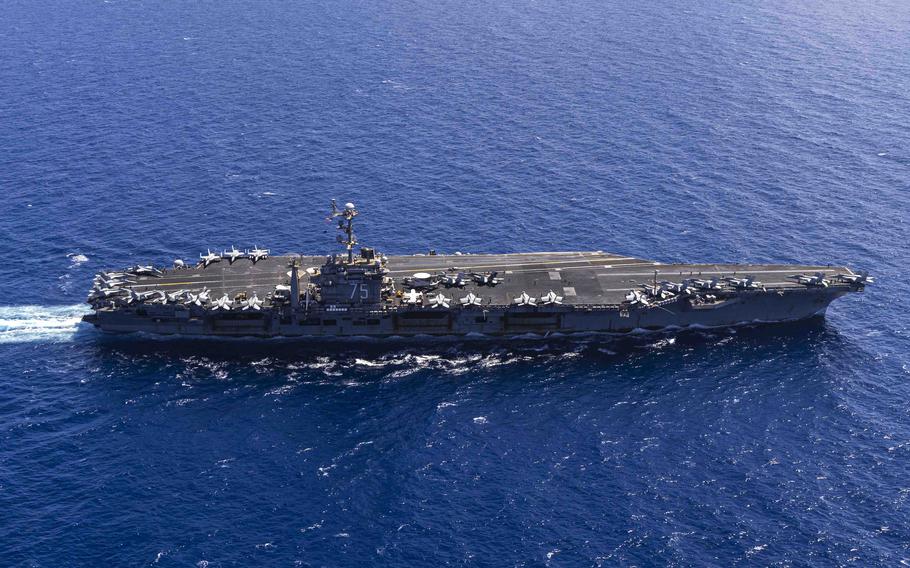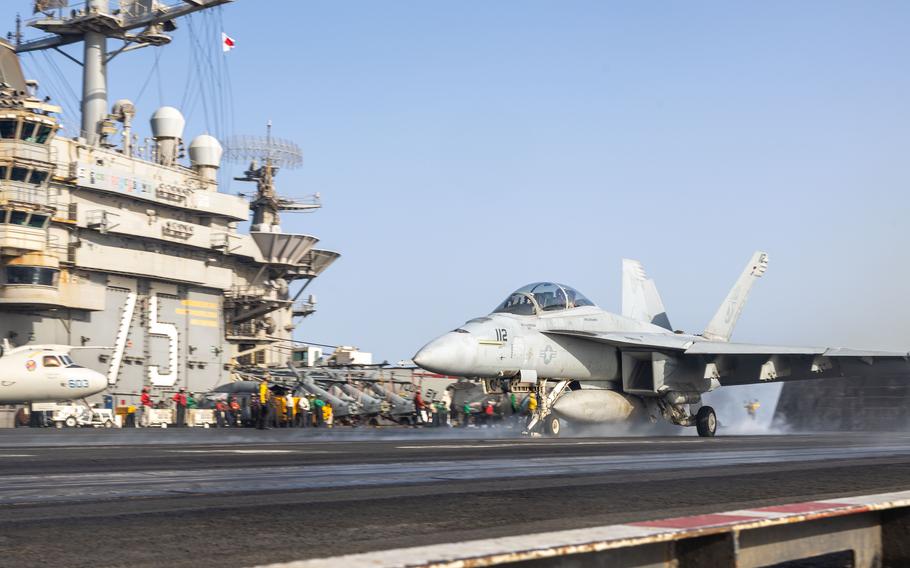
The Nimitz-class aircraft carrier USS Harry S. Truman sails through the Mediterranean Sea on May 18, 2025. The Truman and its strike group launched the “largest airstrike in the history of the world” during recent operations near Somalia, according to Adm. James Kilby, the acting chief of naval operations. (Mike Shen/U.S. Navy)
WASHINGTON — The USS Harry S. Truman and its strike group launched the “largest airstrike in the history of the world” from an aircraft carrier during recent operations near Somalia, the Navy’s top admiral said Monday.
About 125,000 pounds of munitions were launched by the Harry S. Truman Carrier Strike Group into the African country, Adm. James Kilby, the acting chief of naval operations, said while speaking at the Council on Foreign Relations’ Robert B. McKeon Endowed Series on Military Strategy and Leadership. The annual event brings together U.S. military service chiefs to discuss the future of the American defense strategy, military readiness and emerging global challenges.
U.S. Africa Command, which oversees military operations in the region, is launching airstrikes in Somalia at a record-setting pace as the military seeks to counter an influx of Islamic State group fighters, military figures show. Since January, AFRICOM has conducted 25 strikes in Somalia, many of which were directed at ISIS militants, according to command strike reports. If the intensity of the bombing campaign continues, AFRICOM will exceed the 63 strikes it launched in Somalia in 2019, the highest tally for the country in the command’s history.
The ISIS cell in Somalia has grown from about 500 fighters to 1,500 over the past 18 months, with roughly 60% being foreign, a spokesperson told Stars and Stripes this month.
“ISIS-Somalia has proven both its will and capability to attack U.S. forces. [U.S. Africa Command], alongside the federal government of Somalia and Somali Armed Forces, continues to take action to degrade ISIS-Somalia’s ability to plan and conduct attacks that threaten the U.S. homeland, our forces and our citizens abroad,” the command said on May 3.

An F/A-18F Super Hornet, attached to Strike Fighter Squadron 11, launches from the flight deck of the Nimitz-class aircraft carrier USS Harry S. Truman on May 9, 2025, during flight operations in the U.S Central command area of responsibility. (Logan McGuire/U.S. Navy)
Meanwhile, the Truman strike group, Kilby added, has played a vital role in deterring Iran-backed Houthi militants in Yemen from attacking maritime shipping in the Red Sea. The Truman, he said, conducted 670 strikes and intercepted around 160 enemy drones and missiles during the five months it spent in the Red Sea.
“[The Houthis] are not China, but they are a threat, and they are hunting our ships,” Kilby said. “Understanding that and not being dismissive about that and being prepared is what we are focused on now.”
Truman left its homeport in Norfolk, Va., on Sept. 23 for a routine deployment to the 6th Fleet. It entered the Middle East on Dec. 14 following the departure of the aircraft carrier USS Abraham Lincoln.
The aircraft carrier and its strike group were due to return to the U.S. in the spring, but its deployment was extended in May as part of a U.S. bid to cripple the Houthi by way of daily strikes.
Since March 15, U.S. forces have hit more than 1,000 Houthi targets in Yemen, killing group leaders and fighters and degrading the group’s capabilities, the Pentagon said last month. In declaring a ceasefire on May 6, President Donald Trump said the Houthis didn’t want to fight anymore and had agreed to stop attacking ships in the vital waterway.
As of Monday, the Truman, as well as the destroyer USS Jason Dunham and the cruiser USS Gettysburg, had left the Red Sea and were in the Mediterranean Sea to participate in a NATO military exercise. The Navy has not said when the carrier strike group will return home.